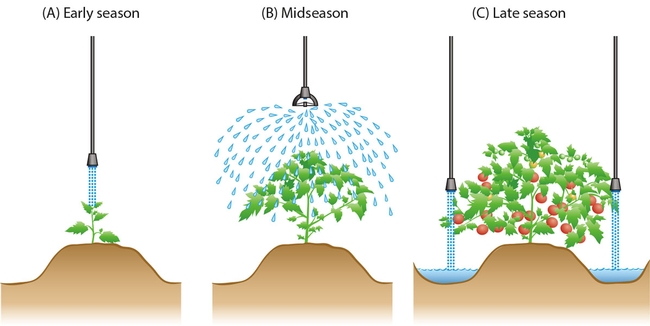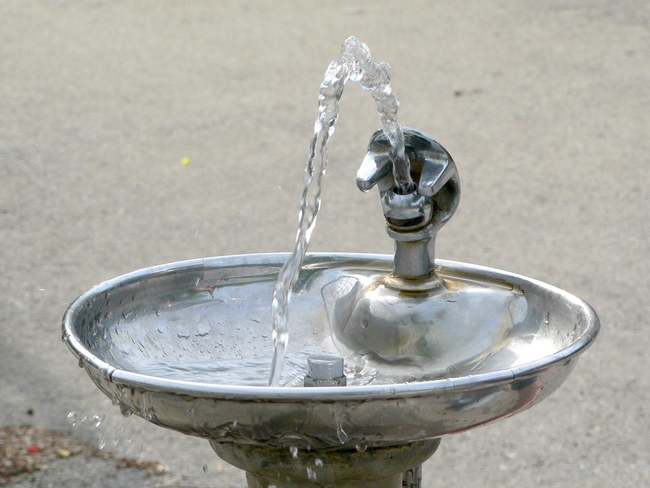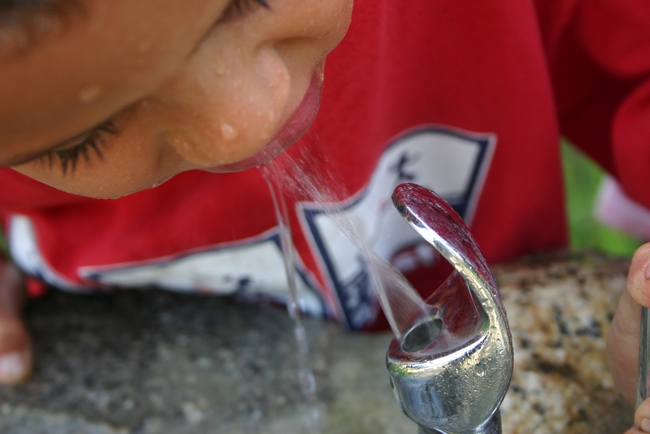Posts Tagged: water
Study finds schools across the nation have too much lead in drinking water
Despite increasing awareness of the issue of lead in drinking water, UC Nutrition Policy Institute and Harvard School of Public Health researchers found that many students in the U.S. attend public schools in states where not all taps are tested for lead, according to reports in various media outlets including The Guardian, NBC News and The Nation.
“All kids, no matter where they live, should have access to safe drinking water in school,” said Angie Cradock of Harvard's Prevention Research Center on Nutrition and Physical Activity, who led the study team. “Drinking water is important for helping kids grow up healthy, and water should be safe to drink.”
The researchers found that there is no uniformity in states' approaches to create and oversee programs to test for elevated lead in school drinking water. When collected, data are not regularly made available to guide action to reduce potential exposure to lead. About half of the country's students are at public schools in states that don't have programs or requirements to test drinking water in those schools.
Of the 24 states (plus Washington, D.C.) with a statewide program to test school drinking water for lead, only 12 states had data that could be analyzed by the research team. In these 12 states, 44 percent of all schools had at least one tap that tested higher than their state's threshold for action, and 12 percent of all samples had a lead concentration higher than the state's action level. The report also describes the features of statewide initiatives in operation between Jan. 1, 2016, and Feb. 28, 2018, in 24 states and the District of Columbia to conduct testing for lead in school drinking water.
The report was funded by Healthy Eating Research, a national program of the Robert Wood Johnson Foundation.
For more information, see the Harvard T. H. Chan School of Public Health website.
Overhead irrigation holds water-saving potential for California farms
In California, 40 percent of agriculture is still irrigated by pouring water onto farmland, a much less efficient practice that drip and overhead irrigation. But those numbers are changing, reported Matt Weiser on Water Deeply.
Weiser interviewed UC Cooperative Extension cropping systems specialist Jeff Mitchell about the water-saving potential of using overhead irrigation, a system that is popular in other parts of the nation and world, but only used on 2 percent of California farmland. Mitchell was the primary author of a research article in the current issue of California Agriculture journal, which said that water and money can be saved using overhead irrigation in production of wheat, corn, cotton, onion and broccoli.
Mitchell said California researchers are looking more closely at overhead irrigation because they anticipate future constraints on agriculture, including water and labor shortages. Additionally, the system is ideal for combining with conservation agriculture systems, which include the use of cover crops, leaving crop residue on the soil surface and reducing tillage disturbance of the soil. The combination of overhead irrigation and conservation agriculture practices reduces water use, cuts back on dust emissions, increases yield and improves the soil.
Weisner asked how overhead irrigation could be as efficient as drip, when people typically see "water spraying everywhere from these roving sprinklers high off the ground."
Mitchell said farmers use pressure regulators and a variety of nozzles on hoses hanging down from the system to deliver water at precisely the rate and location where it is needed through the season.
"So, they're not spraying water. These are low to the ground, and there are various delivery nozzle practices that can be used," Mitchell said.
Avoiding the water quality problems suffered in Flint
Congress and health groups are looking at a provision of a 2010 child nutrition law to get schools to test their water, and considering how to help schools pay for it.
The Politico reporter spoke to Christina Hecht, a senior policy adviser at the UC ANR Nutrition Policy Institute. The institute is the hub for the National Drinking Water Alliance, a network of organizations and individuals across the country working to ensure that American children can drink safe water in the places where they live, learn and play.
Hecht pointed out that the Healthy Hunger-Free Kids Act of 2010 requires schools to provide potable water during meal times. The act also says that child care facilities that participate in federal meals programs must give kids access to drinkable water throughout the day.
Because of this wording in the law, USDA could issue a guidance requiring schools to test their water to be sure it is potable.
"The beauty of this approach is that the language is there ... the means for oversight is there," Hecht said. "When you look at Flint, where does the buck stop? When you look at schools and child care, we've identified where the buck stops."
The cost to test water at schools nationwide is estimated to be about $7.6 million. For adult and child-care sites it would be about $14 million. In all, the expenditure works out to about 40 cents per child.
"We at the Nutrition Policy Institute encourage Congress to appropriate funds for tap water testing in American schools, and remediation where necessary," Hecht said.
UC ANR vice president Glenda Humiston visits the Imperial Valley
Humiston visited local farms, the Salton Sea, and UC Desert Research and Extension Center and UC Cooperative Extension in Imperial County. She had discussions with local farmers and industry representatives about renewable energy, drought and water issues, and agricultural production.
"It's great ot have our new vice president here to learn about the programs that we have here and discuss how we can improve them and bring more resources to the area," said Khaled Bali, director of UCCE in Imperial County. "That is basically my objective, bringing more resources to the area and have more collaborative projects."
Andy Horne, a Imperial County executive, said that solar farms have expanded in the county. Projects in place and those approved will cover about 4 percent of Imperial County farmland, a level the county intends to maintain. Humiston told the reporter that she is an advocate for farmland protection because the planet as a whole has a limited surface for cultivating crops.
"As we are dealing with things such as climate change and invasive species and drought, not only protecting those acres so that they are available but keeping them healthy and making sure water is available becomes ever more important," Humiston said.
Delgado reported that Humiston's trip to the Imperial Valley is part of an effort to visit all the UC Cooperative Extension offices and the nine research and extension centers around the state to familiarize herself with UC ANR efforts throughout California.
“The issues going on here are completely different than the Central Coast, Northern Sierras or Sacramento Valley,” Humiston said. “What is important is that we, the University of California, we have these offices in each and every county and that we have these research centers because if we are going to develop knowledge and find solutions and be able to implement those, we got to be able to have people in the ground here that can really dig into the real problem. You got to have people on the ground.”
The debate over dairy products is being milked for all its worth
Since the 1960s, nutrition experts have encouraged Americans to forgo whole milk in favor of skim or low-fat dairy products. Now some scientists are saying the move to low-fat dairy is tied to the country's obesity crisis, according to an article in The Guardian
Robert Lustig, professor of pediatric medicine at UC San Francisco, said he believes drinking whole milk can lead to lower calorie intake overall because it is more filling than low-fat and non-fat alternatives.
A UC Agriculture and Natural Resources (UC ANR) expert shared a different viewpoint. Lorrene Ritchie, director of the UC ANR Nutrition Policy Institute, said low-fat or skim milk products are still preferable to whole milk because liquid calories are not as filling as equivalent calories from solid food. Nationwide, the goal for most people should be to reduce calorie intake.
"Until we decrease calorie intake on a population level, we are unlikely to see much reversal in the obesity epidemic," Ritchie said.
Before the end of 2015, the federal government is expected to release its revised Dietary Guidelines for Americans. According to the Guardian article, the guidelines are expected to tout vegetables, fruits, whole grains, legumes, nuts, seafood and "low- or non-fat dairy." The guidelines inform the USDA's dietary infographic, which at the moment takes the form of a plate half filled with vegetables and fruit, and the other half with a small portion of protein food and whole grains.
The Nutrition Policy Institute has been advocating for the addition of water on the MyPlate icon to reinforce its position that plain tap water is the best choice for quenching thirst.





